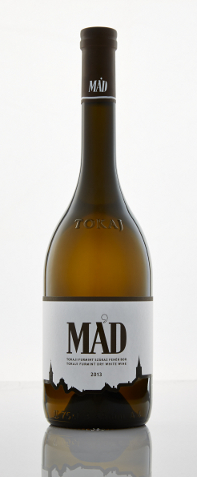Furmint
| Furmint | |
|---|---|
Gouais Blanc | |
| Notable wines | Tokaji |
| Formation of seeds | Complete |
| Sex of flowers | Hermaphrodite |
| VIVC number | 4292 |
Furmint (also known as Mainak) is a white
The name Furmint may have been taken from the word froment for the wheat-gold color of the wine it produces. While it is possible that the grape was brought to Hungary in the 13th century during the reign of King
History
Furmint has been growing in the Tokaji region of north-eastern Hungary since at least the late 16th century when a document dated May 15, 1571 described the grape growing in the Hétszőlő vineyard in Tokaj. In 1611, the grape was also noted to have been growing in the Gyepű Valley of the Zemplén Mountains near the town of Erdőbénye, about 20 kilometres (12 mi) north of Tokaj.[5]
While many other wine grapes have been used in the production of the historic Tokaji dessert wine, Furmint's use for the wine was well established by at least the late 18th century when, in 1796, the Hungarian politician János Dercsényi described Furmint as the "genuine Tokaji Aszú" grape.[5]
Origins

In the early 21st century,
DNA analysis also suggested that parent-offspring relationships exist with the Hungarian wine grape Hárslevelű and the Swiss wine grape Plantscher but instead of either being the second parent to Furmint with Gouais blanc, ampelographers believe that it is more likely that Furmint is one of the parent variety for both grapes.[5]
Like
Other theories

Other theories of Furmint's origins have the grape being introduced to the
Another theory has the grape being introduced even early by Italian missionaries during the reign of
However, ampelographers often dismiss these Italian origin theories because, in addition to documentation showing Furmint growing in Hungary before the Seven Years' War, DNA evidence has not connected Furmint to any
Other theories for Furmint's origin note the grape's similarities to the Savoy wine grape Altesse and speculate that the grape may have originated there or even in Byzantium where, according to legend, Altesse was brought back to Savoy in 1367 by Amadeus VI, Count of Savoy. The Syrmia region with Serbia has also been listed as one potential birthplace for the grape.[5]
Viticulture

Furmint is a late-ripening grape variety that also tends to
In Hungary, Furmint has shown a high degree of genetic diversity with several clones and color mutation of the grape being propagated in the Tokaji region. Several of these clones, including the Fehér (white), Holyagos and Madárkás clones were well known and in production prior to World War II. Other common clones of Furmint used in wine production includes the loose-berried Lazafürtű and the Változó (variable) clone and the pink-skinned color mutation of Piros Furmint. Ampelographers have noted the proliferation of so many clones of Furmint found almost exclusively in the Tokaj region of Hungary are strong indicators that the grape likely originated in this region as opposed to be introduced from another area.[5]
Relationship to other grapes

DNA profiling conducted at the University of Zagreb has shown Furmint to be likely to have a parent-offspring relationship with Gouais blanc, which similar research elsewhere has shown to be a parent of numerous other varieties, making Furmint a half-sibling to nearly 80 different grape varieties. Furmint has also been confirmed to be the same grape as the Croatian white variety Moslavac.[2]
Currently, there are only two known (or suspected) natural crossings of Furmint—the Tokaji wine grape Hárslevelű and the Swiss wine grape Plantscher. In 1937, Furmint was
Confusion with other varieties
Furmint shares a wide range of
The grape shares some
Wine regions

In 2006, there were 4,006 hectares (9,900 acres) of Furmint in cultivation in Hungary, more than 97% of which found in the

Outside Hungary
Outside Hungary, it is found planted around the
In the
Across the border from Hungary, in
In

In the
Wines and styles
Furmint can be produced in a variety of styles ranging from bone dry to extremely sweet wines affected by
Dry styles of Furmint are characterized by their
Synonyms
Over the years, Furmint has been known under a variety of synonyms including: Allgemeiner, Alte Sestrebe, Arany Furmint, Beregi Furmint, Bieli Moslavac, Biharboros, Bihari Boros, Budai Goher, Cimigera, Csapfner, Csillagviraga Furmint, Damzemy, Demjen, Domjen, Edelweisser Tokayer, Edler weisser Furmint, Féher Furmint (in Tokaj), Formint, Formont, Fourminte, Furmint bianco, Furmint de Minis, Furmint Féher, Furmint Szagos, Furmint Valtozo, Gelber Moster, Gemeiner, Görgeny, Görin, Goher Féher, Gorin, Grasă de Cotnari, Holyagos Furmint, Jardanszki Furmint, Keknyelü, Keresztesevelu Furmint, Kiraly Furmint, Krhkopetec, Lazafürtű Furmint (in Tokaj), Ligetes Furmint, Luttenberger, Madarkas Furmint, Mainak, Maljak, Malmsey, Malnik, Malvasia verde, Malvoisie verte, Malzak, Mehlweiss, Moscavac bijeli, Moslavac, Moslavac bijeli, Moslavac zuti, Moslavina, Mosler (in Austria), Mosler gelb, Mosler gelber, Moslertraube, Moslovac (in Croatia), Moslovez, Nemes Furmint, Poam Grasa, Poma Grasa, Poshipon, Pošip, Pošipbijeli, Pošipveliki, Pošip Vrgonski, Posipel, Posipon, Pospisel, Rongyos Furmint, Salver, Sari Furmint, Sauvignon Vert, Schimiger, Schmiger, Seestock, Seeweinrebe, Shipo, Shipon, Shiponski, Sipelj, Šipon (in Slovenia and northern Croatia), Som (in
References
- ^ ISBN 0-15-100714-4
- ^ ISBN 0-19-860990-6
- ^ a b DiWine Taste "Hungary wine" Issue 11, September 2003
- ^ a b Wein-Plus Glossar: "Hungary" Accessed: December 18th, 2009
- ^ ISBN 978-1-846-14446-2
- ^ Cav. Subhash Arora "Tokaj wine region of Slovakia" Indian Wine Academy. April 15th, 2008
- ^ Appellation America "Furmint" Varietal Character Index, Accessed: May 13th, 2014
- ^ Vitis International Variety Catalogue (VIVC) Furmint Archived 2014-03-15 at the Wayback Machine Accessed: May 13th, 2014
